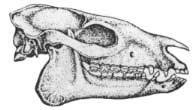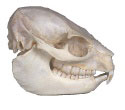
 |
Freethought & Rationalism ArchiveThe archives are read only. |
|
|
#1 | |
|
Senior Member
Join Date: Nov 2001
Location: Ecuador
Posts: 738
|
Okay, in the midst of a typical long series of creationist quote mining on evcforum, bashing the Hyracotherium to equiid lineage, my opposite number came up with a quote I haven't encountered, and can't find a decent reference rebutting or explaining. Since the thread was closed (it was waaaaay off topic), I've got time to prepare a really scathing reply, so would like to close the loop on this quote as well.
Quote:
So does anyone have any info on either Froelich himself or the apparent claim that Hyracotherium is no longer considered an ancestor of the equiids, tapirids, etc. Perhaps someone has access to the original Journal of Vertebrate Paleontology article? There appear to be at least two possible alternative explanations going on here, but sitting in Ukraine without library access is killing me... Thanks for your help. |
|
|
|
|
|
#3 | |
|
Contributor
Join Date: Sep 2000
Location: Alibi: ego ipse hinc extermino
Posts: 12,591
|
Dear oh dear, Morpho, never heard of Google?
 What I assume is the abstract is here: What I assume is the abstract is here:http://www.vertpaleo.org/jvp/19-140-159.html Quote:
[Edited to stick in some paragraphs. It's a bit more comprehensible now.] I�ve heard Froehlich�s name before, and the Google for him and hyracotherium which found that also brings up enough stuff to make me think the guy does know what he�s talking about. He�s certainly no creationist, it just seems that hyracotherium is a basal palaeothere, not an equid. IOW, close, but not the right critter. There�s a cladogram at here, but with that daisy-wheel-printout design, I can�t make head nor tail of it  . .See also Froehlich�s post here: http://www.cmnh.org/dinoarch/1996Feb/msg00473.html An amusing aside: it seems that person who lost Marsh�s type specimen of Hyraco / Eohippus was the hot-blooded dino chap Bob Bakker.... Not quite sure why I find that funny, but I do.  So Morpho, what was your creationist saying? Looks to me, insofar as I can tell, that this is no different to deciding that, say, Australopithecus africanus is a side branch, not on the direct line. But as any cladist will tell you, we�re very unlikely to find stuff actually on the line, only the stuff near it (that, I gather, is why cladograms are drawn like that!) Hope that helps. This also looks like a job for Patrick (ps418). If he doesn�t show up, you could email him: his details are on page 8 of the P�s. Cheers, DT |
|
|
|
|
|
#4 |
|
Senior Member
Join Date: Nov 2001
Location: Ecuador
Posts: 738
|
Thanks DT et al.
I got that part, actually - including the abstract from the journal (google my left, erm, whatever  ). That's not the problem. The difficulty is the cretinist is using the article to bolster his claim (based on our old pal Gish's famous Impact #87 article) that Hyracotherium is a hyrax, by claiming that Froelich is saying it's not an equiid (or rather, basal to the equiids). And yes, I've got all the usual counters - teeth, toe pads vs heel pads, etc. Heck, here's the thread if you're interested: start here, although bart's quote mine started back in msg #66. I can easily eviscerate the quote mine, but I need somebody to 'splain me what Froehlich was REALLY talking about so I can hammer the only substantive bit of actual information my, uhhh, "counterpart" came up with. ). That's not the problem. The difficulty is the cretinist is using the article to bolster his claim (based on our old pal Gish's famous Impact #87 article) that Hyracotherium is a hyrax, by claiming that Froelich is saying it's not an equiid (or rather, basal to the equiids). And yes, I've got all the usual counters - teeth, toe pads vs heel pads, etc. Heck, here's the thread if you're interested: start here, although bart's quote mine started back in msg #66. I can easily eviscerate the quote mine, but I need somebody to 'splain me what Froehlich was REALLY talking about so I can hammer the only substantive bit of actual information my, uhhh, "counterpart" came up with.My motivation for opening a new thread on evcforum in response is the diatribe in message 87 - I ain't a' gonna let that slide - them's fightn' words. 
|
|
|
|
|
#5 | ||
|
Contributor
Join Date: Sep 2000
Location: Alibi: ego ipse hinc extermino
Posts: 12,591
|
Quote:
Hyracotherium:  Hyrax:  (Ah, have looked at the thread, and see you�ve already done the pic thing. Still, I like a nice picture, and hope the lurkers here do too  .) .)I suspect what Froehlich was saying is pretty well covered in the abstract, that Hyraco isn�t a direct horse ancestor. But so? It ain�t no hyrax either, and, most importantly, it is a bloody sight closer to being a horse ancestor than it is to a hyrax. Right time, right place, and morphology right enough that it was thought to be ancestral for a long time. Like I say, we won�t generally be finding things on the direct line anyway. If he wants a basal equid, then we�re all out of luck. If he�s only bothered about the hyrax connection, then you�ve got him anyway. I love his sentence: Quote:
Which isn�t much help really I guess. It�d be nice to have something easy to hit this bozo with (a baseball bat springs to mind  ), rather than have to explain cladistics to him. But that�s the nature of these discussions. The more you explain, the more you have to explain. ), rather than have to explain cladistics to him. But that�s the nature of these discussions. The more you explain, the more you have to explain.Cheers, DT |
||
|
|
|
|
#6 |
|
Contributor
Join Date: Jul 2000
Location: Lebanon, OR, USA
Posts: 16,829
|
Here's a short summary:
There is not much to distinguish different species of early perissodactyls, and they have few of the distinctive features of different groups of present-day perissodactyls. In other words, there is not much that can be used to determine whether some early perissodactyl was an ancestor of the horses, the tapirs, the rhinos, any combination of these, or none of these. However, a likely conclusion is that "none of these" applies for Hyracotherium; it is thus an offshoot that has left no present-day survivors. My comment: That difficulty in distinguishing ancestors from offshoots shows that higher-level intermediates are common in the fossil record, even if intermediates between many fossil species are not. |
|
|
|
|
#7 |
|
Senior Member
Join Date: Nov 2001
Location: Ecuador
Posts: 738
|
Thanks, DT - I think I'm getting the glimmer of an idea for a response.
lp, once I open the thread, feel free to jump in - especially if you see that I'm making some kind of mistake (it's nice to have someone backstop on these things.) I'd rather be corrected in open forum than say something stupid... |
|
|
|
|
#8 |
|
Moderator - Science Discussions
Join Date: Feb 2001
Location: Providence, RI, USA
Posts: 9,908
|
lpetrich:
However, a likely conclusion is that "none of these" applies for Hyracotherium; it is thus an offshoot that has left no present-day survivors. Well, from a cladistics point of view we shouldn't even ask whether Hyracotherium is a direct ancestor of horses or not, the important question is whether it shares a more recent common ancestor with horses than with other perissodactyls...what's the general opinion on this? |
|
|
|
|
#9 |
|
Veteran Member
Join Date: Feb 2001
Location: Quezon City, Philippines
Posts: 1,994
|
Yes, cladistics do frown upon ancestor-descendant evolutionary scenarios. To them, all oganisms are part of ever increasing nested hierarchies, of sister-organisms, sister-groups, sister-taxa, etc, with ever diverging evolutionary relationships. Henry Gee's book In Search of Deep Time is a good intro to cladistics.
|
|
|
|
|
#10 | ||
|
Junior Member
Join Date: Dec 2002
Location: Houston, TX
Posts: 62
|
Quote:
Quote:
Regards, Darwin's Beagle |
||
|
|
| Thread Tools | Search this Thread |
|